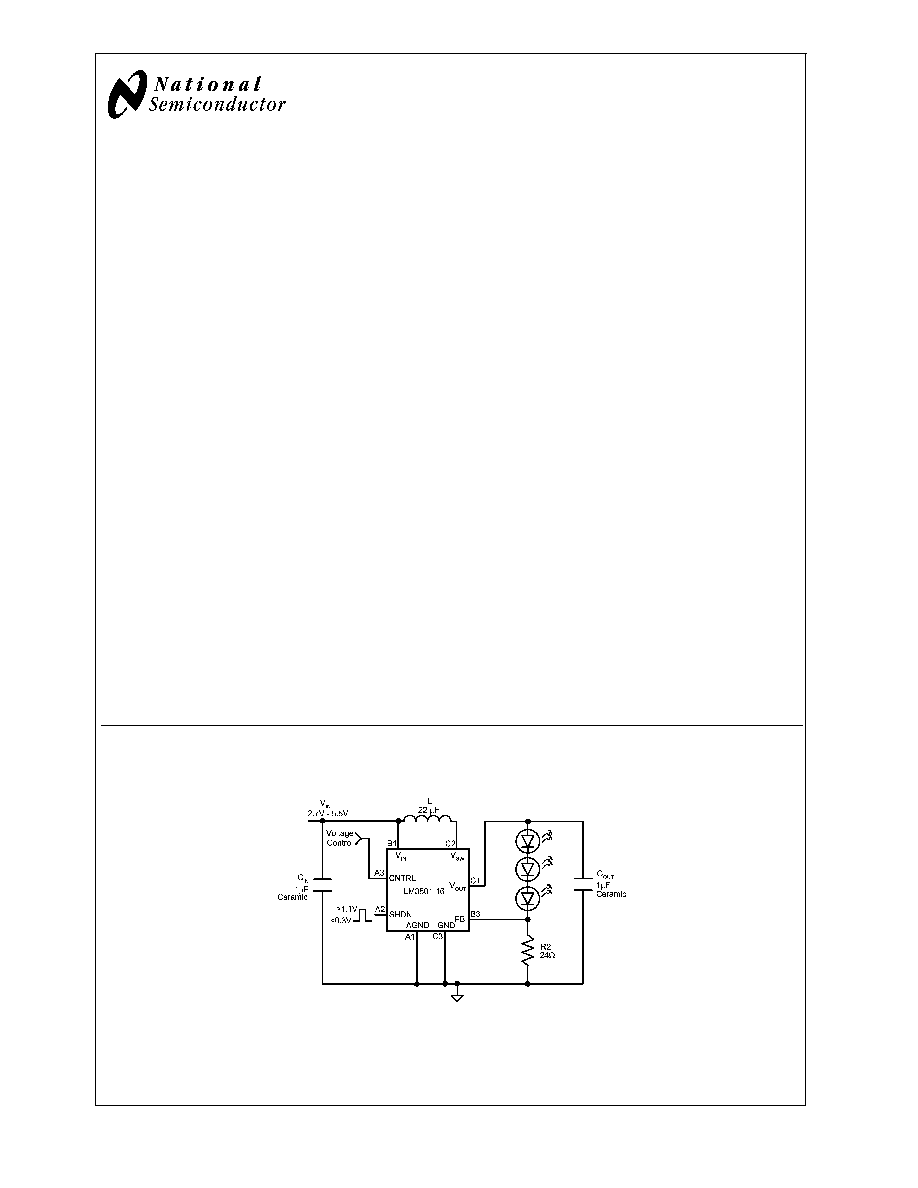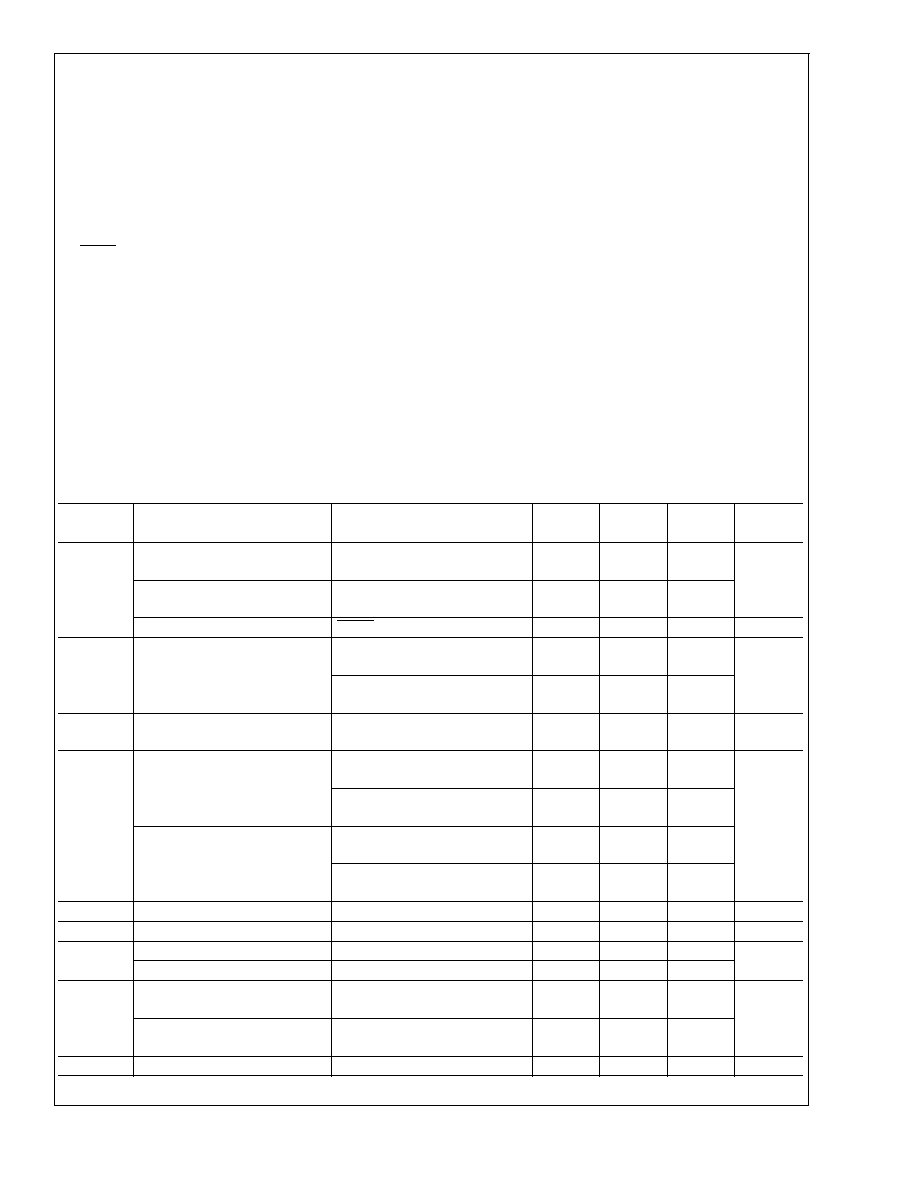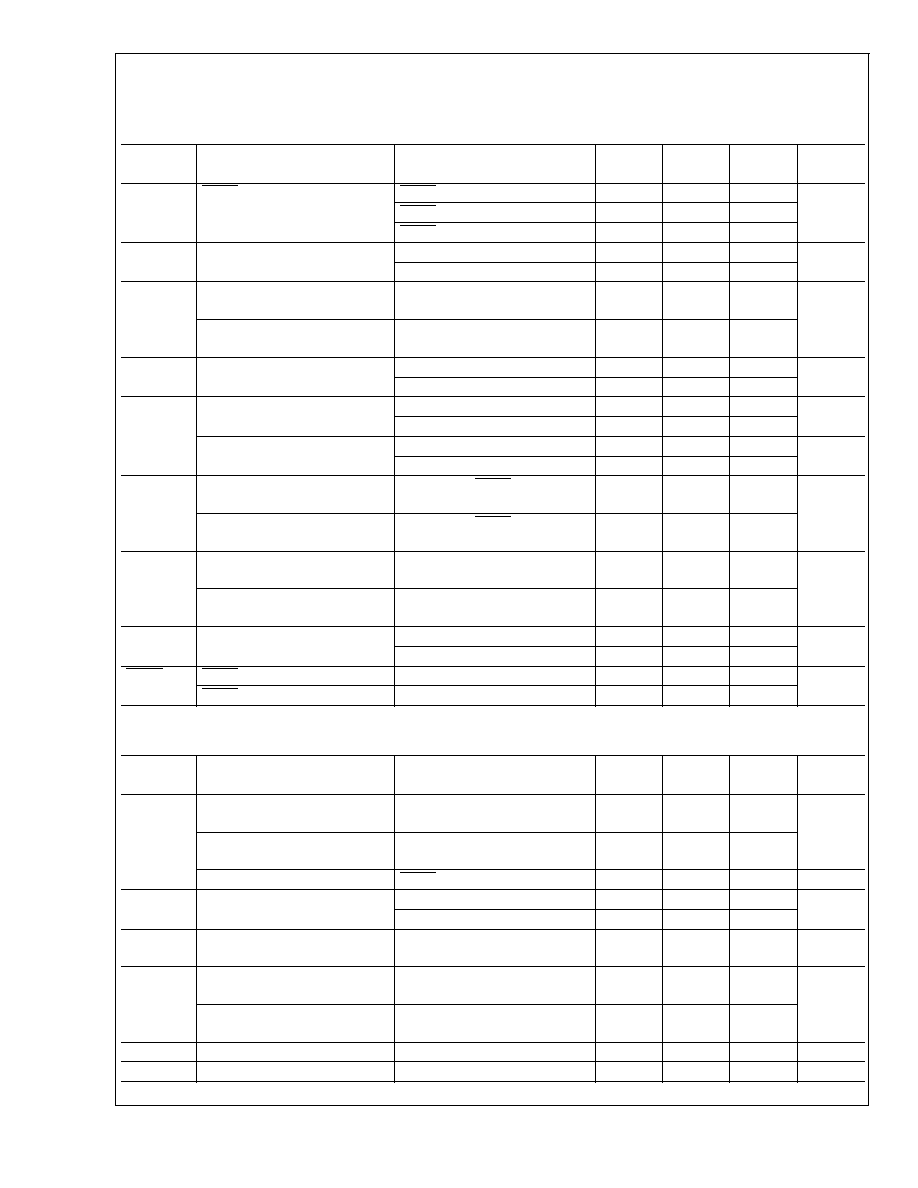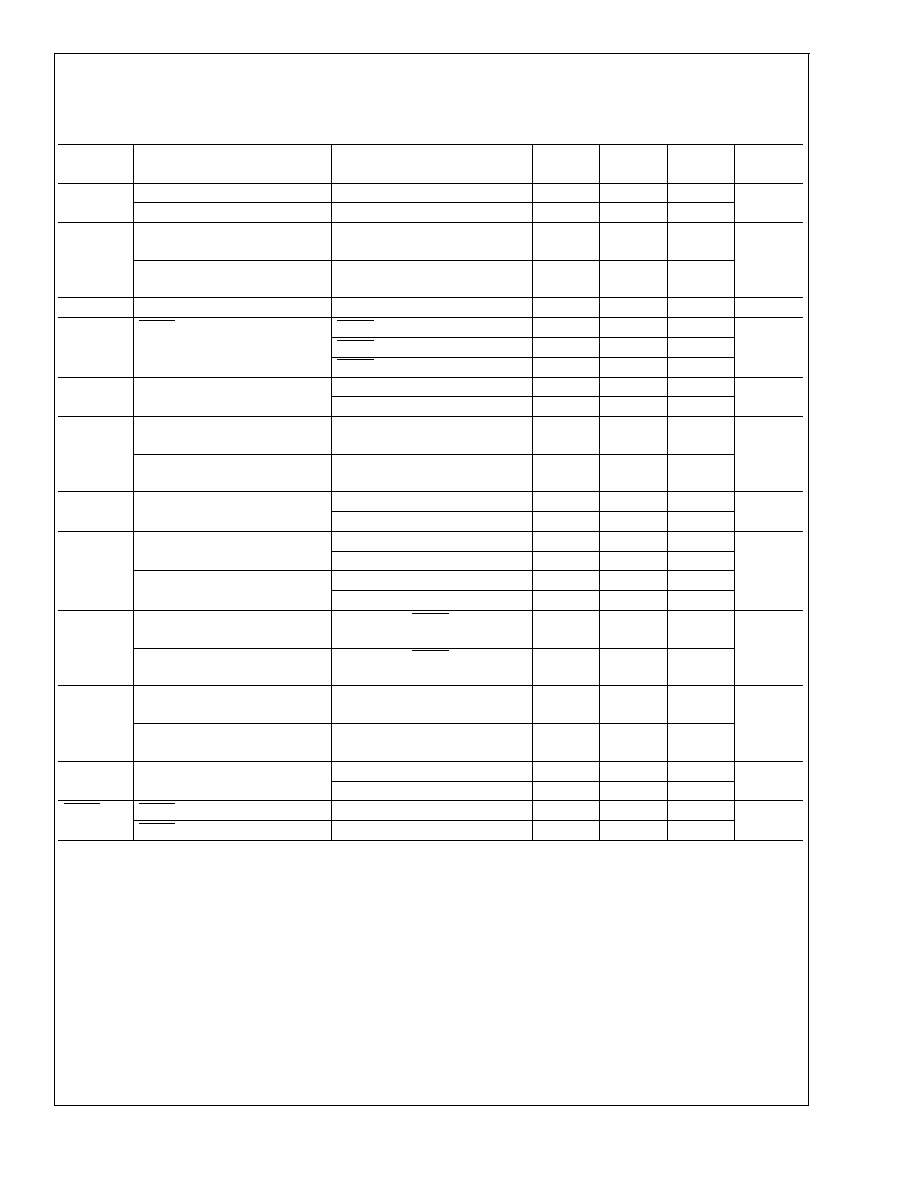
LM3501
Synchronous Step-up DC/DC Converter for White LED
Applications
General Description
The LM3501 is a fixed-frequency step-up DC/DC converter
that is ideal for driving white LEDs for display backlighting
and other lighting functions. With fully intergrated synchro-
nous switching (no external schottky diode required) and a
low feedback voltage (515 mV), power efficiency of the
LM3501 circuit has been optimized for lighting applications
in wireless phones and other portable products (single cell
Li-Ion or 3-cell NiMH battery supplies). The LM3501 oper-
ates with a fixed 1 MHz switching frequency. When used with
ceramic input and output capacitors, the LM3501 provides a
small, low-noise, low-cost solution.
Two LM3501 options are available with different output volt-
age capabilities. The LM3501-21 has a maximum output
voltage of 21V and is typically suited for driving 4 or 5 white
LEDs in series. The LM3501-16 has a maximum output
voltage of 16V and is typically suited for driving 3 or 4 white
LEDs in series (maximum number of series LEDs dependent
on LED forward voltage). If the primary white LED network
should be disconnected, the LM3501 uses internal protec-
tion circuitry on the output to prevent a destructive overvolt-
age event.
A single external resistor is used to set the maximum LED
current in LED-drive applications. The LED current can eas-
ily be adjusted by varying the analog control voltage on the
control pin or by using a pulse width modulated (PWM)
signal on the shutdown pin. In shutdown, the LM3501 com-
pletely disconnects the input from output, creating total iso-
lation and preventing any leakage currents from trickling into
the LEDs.
Features
n
Synchronous rectification, high efficiency and no
external schottky diode required
n
Uses small surface mount components
n
Can drive 2-5 white LEDs in series (may function with
more low V
F
LEDs)
n
2.7V to 7V input range
n
True shutdown isolation, no LED leakage current
n
DC voltage LED current control
n
Input undervoltage lockout
n
Internal output over-voltage protection (OVP) circuitry,
with no external zener diode required LM3501-16: 15.5V
OVP; LM3501-21: 20.5V OVP.
n
Requires only a small 16V (LM3501-16) or 25V
(LM3501-21) ceramic capacitor at the input and output
n
Thermal Shutdown
n
0.1µA shutdown current
n
Small 8-bump thin micro SMD package
Applications
n
LCD Bias Supplies
n
White LED Back-Lighting
n
Handheld Devices
n
Digital Cameras
n
Portable Applications
Typical Application Circuit
20065301
FIGURE 1. Typical 3 LED Application
May 2005
Synchronous
Step-up
DC/DC
Converter
for
White
LED
Applications
© 2005 National Semiconductor Corporation
DS200653
www.national.com

Connection Diagram
Top View
20065302
8-bump micro SMD
Ordering Information
Order Number
Package Type
NSC Package Drawing
Top Mark
Supplied As
LM3501TL-16
micro SMD
TL08SSA
19
250 Units, Tape and Reel
LM3501TLX-16
micro SMD
TL08SSA
19
3000 Units, Tape and Reel
LM3501TL-21
micro SMD
TL08SSA
30
250 Units, Tape and Reel
LM3501TLX-21
micro SMD
TL08SSA
30
3000 Units, Tape and Reel
Pin Description/Functions
Pin
Name
Function
A1
AGND
Analog ground.
B1
V
IN
Analog and Power supply input.
C1
V
OUT
PMOS source connection for synchronous rectification.
C2
V
SW
Switch pin. Drain connections of both NMOS and PMOS power devices.
C3
GND
Power Ground.
B3
FB
Output voltage feedback connection.
A3
CNTRL
Analog LED current control.
A2
SHDN
Shutdown control pin.
AGND (pin A1): Analog ground pin. The analog ground pin
should tie directly to the GND pin.
V
IN
(pin B1):Analog and Power supply pin. Bypass this pin
with a capacitor, as close to the device as possible, con-
nected between the V
IN
and GND pins.
V
OUT
(pin C1):Source connection of internal PMOS power
device. Connect the output capacitor between the V
OUT
and
GND pins as close as possible to the device.
V
SW
(pin C2):Drain connection of internal NMOS and PMOS
switch devices. Keep the inductor connection close to this
pin to minimize EMI radiation.
GND (pin C3):Power ground pin. Tie directly to ground
plane.
FB (pin B3):Output voltage feedback connection. Set the
primary White LED network current with a resistor from the
FB pin to GND. Keep the current setting resistor close to the
device and connected between the FB and GND pins.
CNTRL (pin A3): Analog control of LED current. A voltage
above 125 mV will begin to regulate the LED current. De-
creasing the voltage below 75 mV will turn off the LEDs.
SHDN (pin A2):Shutdown control pin. Disable the device
with a voltage less than 0.3V and enable the device with a
voltage greater than 1.1V. The white LED current can be
controlled using a PWM signal at this pin. There is an
internal pull down on the SHDN pin, the device is in a
normally off state.
LM3501
www.national.com
2

Absolute Maximum Ratings
(Note 1)
If Military/Aerospace specified devices are required,
please contact the National Semiconductor Sales Office/
Distributors for availability and specifications.
V
IN
-0.3V to 7.5V
V
OUT
(LM3501-16)(Note 2)
-0.3V to 16V
V
OUT
(LM3501-21)(Note 2)
-0.3V to 21V
V
SW
(Note 2)
-0.3V to V
OUT
+0.3V
FB Voltage
-0.3V to 7.5V
SHDN Voltage
-0.3V to V
IN
+0.3V
CNTRL
-0.3V to 7.5V
Maximum Junction Temperature
150∞C
Lead Temperature
(Soldering 10 sec.)
300∞C
Vapor Phase
(60 sec.)
215∞C
Infrared
(15 sec.)
220∞C
ESD Ratings (Note 3)
Human Body Model
2kV
Machine Model
200V
Operating Conditions
Junction Temperature
(Note 4)
-40∞C to +125∞C
Supply Voltage
2.7V to 7V
CNTRL Max.
2.7V
Thermal Properties
Junction to Ambient Thermal
Resistance (
JA
) (Note 5)
75∞C/W
Electrical Characteristics
Specifications in standard type face are for T
A
= 25∞C and those in boldface type apply over the Operating Temperature
Range of T
A
= -10∞C to +85∞C. Unless otherwise specified V
IN
= 2.7V and specifications apply to both LM3501-16 and
LM3501-21.
Symbol
Parameter
Conditions
Min
(Note 6)
Typ
(Note 7)
Max
(Note 6)
Units
I
Q
Quiescent Current, Device Not
Switching
FB
>
0.54V
0.95
1.2
mA
Quiescent Current, Device
Switching
FB = 0V
2
2.5
Shutdown
SHDN = 0V
0.1
2
µA
V
FB
Feedback Voltage
CNTRL = 2.7V,
V
IN
= 2.7V to 7V
0.485
0.515
0.545
V
CNTRL = 1V,
V
IN
= 2.7V to 7V
0.14
0.19
0.24
V
FB
Feedback Voltage Line
Regulation
V
IN
= 2.7V to 7V
0.1
0.5
%/V
I
CL
Switch Current Limit
(LM3501-16)
V
IN
= 2.7V,
Duty Cycle = 80%
275
400
480
mA
V
IN
= 3.0V,
Duty Cycle = 70%
255
400
530
Switch Current Limit
(LM3501-21)
V
IN
= 2.7V,
Duty Cycle = 70%
420
640
770
V
IN
= 3.0V,
Duty Cycle = 63%
450
670
800
I
B
FB Pin Bias Current
FB = 0.5V (Note 8)
45
200
nA
V
IN
Input Voltage Range
2.7
7.0
V
R
DSON
NMOS Switch R
DSON
V
IN
= 2.7V, I
SW
= 300 mA
0.43
PMOS Switch R
DSON
V
OUT
= 6V, I
SW
= 300 mA
1.3
2.3
D
Limit
Duty Cycle Limit
(LM3501-16)
FB = 0V
80
87
%
Duty Cycle Limit
(LM3501-21)
FB = 0V
85
94
F
SW
Switching Frequency
0.85
1.0
1.15
MHz
LM3501
www.national.com
3

Electrical Characteristics
(Continued)
Specifications in standard type face are for T
A
= 25∞C and those in boldface type apply over the Operating Temperature
Range of T
A
= -10∞C to +85∞C. Unless otherwise specified V
IN
= 2.7V and specifications apply to both LM3501-16 and
LM3501-21.
Symbol
Parameter
Conditions
Min
(Note 6)
Typ
(Note 7)
Max
(Note 6)
Units
I
SD
SHDN Pin Current (Note 9)
SHDN = 5.5V
1.8
4
µA
SHDN = 2.7V
1
2.5
SHDN = GND
0.1
I
CNTRL
CNTRL Pin Current (Note 9)
V
CNTRL
= 2.7V
10
20
µA
V
CNTRL
= 1V
4
15
I
L
Switch Leakage Current
(LM3501-16)
V
SW
= 15V
0.01
0.5
µA
Switch Leakage Current
(LM3501-21)
V
SW
= 20V
0.01
2.0
UVP
Input Undervoltage Lockout
ON Threshold
2.4
2.5
2.6
V
OFF Threshold
2.3
2.4
2.5
OVP
Output Overvoltage Protection
(LM3501-16)
ON Threshold
15
15.5
16
V
OFF Threshold
14
14.6
15
Output Overvoltage Protection
(LM3501-21)
ON Threshold
20
20.5
21
V
OFF Threshold
19
19.5
20
I
Vout
V
OUT
Bias Current
(LM3501-16)
V
OUT
= 15V, SHDN = 1.5V
260
400
µA
V
OUT
Bias Current
(LM3501-21)
V
OUT
= 20V, SHDN = 1.5V
300
460
I
VL
PMOS Switch Leakage Current
(LM3501-16)
V
OUT
= 15V, V
SW
= 0V
0.01
3
µA
PMOS Switch Leakage Current
(LM3501-21)
V
OUT
= 20V, V
SW
= 0V
0.01
3
CNTRL
Threshold
LED power off
75
mV
LED power on
125
SHDN
Threshold
SHDN low
0.65
0.3
V
SHDN High
1.1
0.65
Specifications in standard type face are for T
J
= 25∞C and those in boldface type apply over the full Operating Temperature
Range (T
J
= -40∞C to +125∞C). Unless otherwise specified V
IN
=2.7V and specifications apply to both LM3501-16 and
LM3501-21.
Symbol
Parameter
Conditions
Min
(Note 6)
Typ
(Note 7)
Max
(Note 6)
Units
I
Q
Quiescent Current, Device Not
Switching
FB
>
0.54V
0.95
1.2
mA
Quiescent Current, Device
Switching
FB = 0V
2
2.5
Shutdown
SHDN = 0V
0.1
2
µA
V
FB
Feedback Voltage
CNTRL = 2.7V, V
IN
= 2.7V to 7V
0.485
0.515
0.545
V
CNTRL = 1V, V
IN
= 2.7V to 7V
0.14
0.19
0.24
V
FB
Feedback Voltage Line
Regulation
V
IN
= 2.7V to 7V
0.1
0.5
%/V
I
CL
Switch Current Limit
(LM3501-16)
V
IN
= 3.0V,
Duty Cycle = 70%
400
mA
Switch Current Limit
(LM3501-21)
V
IN
= 3.0V,
Duty Cycle = 63%
670
I
B
FB Pin Bias Current
FB = 0.5V (Note 8)
45
200
nA
V
IN
Input Voltage Range
2.7
7.0
V
LM3501
www.national.com
4

Electrical Characteristics
(Continued)
Specifications in standard type face are for T
J
= 25∞C and those in boldface type apply over the full Operating Temperature
Range (T
J
= -40∞C to +125∞C). Unless otherwise specified V
IN
=2.7V and specifications apply to both LM3501-16 and
LM3501-21.
Symbol
Parameter
Conditions
Min
(Note 6)
Typ
(Note 7)
Max
(Note 6)
Units
R
DSON
NMOS Switch R
DSON
V
IN
= 2.7V, I
SW
= 300 mA
0.43
PMOS Switch R
DSON
V
OUT
= 6V, I
SW
= 300 mA
1.3
2.3
D
Limit
Duty Cycle Limit
(LM3501-16)
FB = 0V
87
%
Duty Cycle Limit
(LM3501-21)
FB = 0V
94
F
SW
Switching Frequency
0.8
1.0
1.2
MHz
I
SD
SHDN Pin Current (Note 9)
SHDN = 5.5V
1.8
4
µA
SHDN = 2.7V
1
2.5
SHDN = GND
0.1
I
CNTRL
CNTRL Pin Current (Note 9)
V
CNTRL
= 2.7V
10
20
µA
V
CNTRL
= 1V
4
15
I
L
Switch Leakage Current
(LM3501-16)
V
SW
= 15V
0.01
0.5
µA
Switch Leakage Current
(LM3501-21)
V
SW
= 20V
0.01
2.0
UVP
Input Undervoltage Lockout
ON Threshold
2.4
2.5
2.6
V
OFF Threshold
2.3
2.4
2.5
OVP
Output Overvoltage Protection
(LM3501-16)
ON Threshold
15
15.5
16
V
OFF Threshold
14
14.6
15
Output Overvoltage Protection
(LM3501-21)
ON Threshold
20
20.5
21
OFF Threshold
19
19.5
20
I
Vout
V
OUT
Leakage Current
(LM3501-16)
V
OUT
= 15V, SHDN = 1.5V
260
400
µA
V
OUT
Leakage Current
(LM3501-21)
V
OUT
= 20V, SHDN = 1.5V
300
460
I
VL
PMOS Switch Leakage Current
(LM3501-16)
V
OUT
= 15V, V
SW
= 0V
0.01
3
µA
PMOS Switch Leakage Current
(LM3501-21)
V
OUT
= 20V, V
SW
= 0V
0.01
3
CNTRL
Threshold
LED power off
75
mV
LED power on
125
SHDN
Threshold
SHDN low
0.65
0.3
V
SHDN High
1.1
0.65
Note 1: Absolute maximum ratings are limits beyond which damage to the device may occur. Operating Ratings are conditions for which the device is intended to
be functional, but device parameter specifications may not be guaranteed. For guaranteed specifications and test conditions, see the Electrical Characteristics.
Note 2: This condition applies if V
IN
<
V
OUT
. If V
IN
>
V
OUT
, a voltage greater than V
IN
+ 0.3V should not be applied to the V
OUT
or V
SW
pins.
Note 3: The human body model is a 100 pF capacitor discharged through a 1.5 k
resistor into each pin. The machine model is a 200 pF capacitor discharged
directly into each pin.
Note 4: The maximum allowable power dissipation is a function of the maximum operating junction temperature, T
J(MAX)
, the junction-to-ambient thermal
resistance,
JA
, and the ambient temperature, T
A
. See the Thermal Properties section for the thermal resistance. The maximum allowable power dissipation at any
ambient temperature is calculated using: P
D
(MAX) = (T
J(MAX)
- T
A
)/
JA
. Exceeding the maximum allowable power dissipation will cause excessive die temperature.
Note 5: Junction-to-ambient thermal resistance (
JA
) is highly application and board-layout dependent. The 75
o
C/W figure provided was measured on a 4-layer test
board conforming to JEDEC standards. In applications where high maximum power dissipation exists, special care must be paid to thermal dissipation issues when
designing the board layout.
Note 6: All limits guaranteed at room temperature (standard typeface) and at temperature extremes (bold typeface). All room temperature limits are production
tested, guaranteed through statistical analysis or guaranteed by design. All limits at temperature extremes are guaranteed via correlation using standard Statistical
Quality Control (SQC) methods. All limits are used to calculate Average Outgoing Quality Level (AOQL).
Note 7: Typical numbers are at 25∞C and represent the most likely norm.
Note 8: Feedback current flows out of the pin.
Note 9: Current flows into the pin.
LM3501
www.national.com
5




